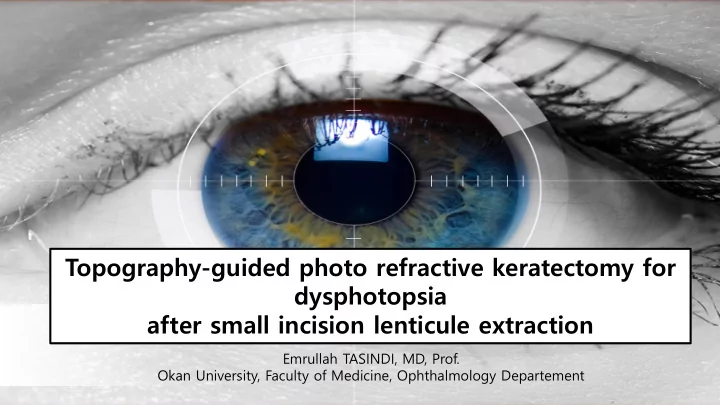

Topography-guided photo refractive keratectomy for dysphotopsia after small incision lenticule extraction Emrullah TASINDI, MD, Prof. Okan University, Faculty of Medicine, Ophthalmology Departement
Purpose To report the outcome of topography guided photorefractive • keratectomy (PRK) in a case with dysphotopsic problems secondary to decentered lenticule extraction after small incision lenticule extraction (SMILE).
Case • 28 year-old woman • Dysphotopsic problems as ghost images, halo and glare 2 years after SMILE surgery • Astigmatism and decentered ablation in both eyes inducing an increase in high order aberrations, coma and spherical aberration.
Case • Pre op Rx: – OD: -1,25 x 175 – OS:-0,75 x 165 • Visual acuity: (CDVA) – OD: 0.4 – OS: 0.8
Case • Bilateral Topography-guided PRK with 0.02% Mitomycine C was performed. • Three months after re-treatment, uncorrected (UDVA) and corrected (CDVA) distance visual acuity, HOA, spherical aberration and coma were evaluated.
Results Subjective symptoms of the • patient were diminished UDVA increased from 0.3 to • 0.8 in OD and from 0.6 to 0.8 in OS CDVA increased from 0.4 • to 0.8 in OD and from 0.8 to 0.9 in OS.
Results • Corneal aberrations were improved
Results • There was no haze development in the follow up period.
Conclusion • Decentered treatment is not an uncommon complication after corneal refractive surgery. • It plays a major role in the induction of higher- order aberrations. • Topography-guided PRK treatment may reduce visual symptoms and increase visual acuity and quality after decentered lenticule extraction.
Thank you….
Recommend
More recommend